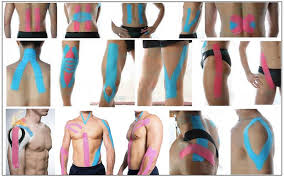
Kinesiology tape, often referred to as Kinesio Tape or KT, is a comfortable, lightweight and flexible adhesive tape that may be applied to joints, muscles, ligaments, and tendons in order to normalize muscle tone, decrease pain and inflammation, and increase range of motion, circulation, and lymph transport.
Kinesiology tape provides neuromuscular feedback known as proprioception. Depending on how the tape is applied, it may facilitate proprioceptive information of muscle, skin, and joint structures by stimulating mechanoreceptors to improve muscle firing. In contrast, kinesiology tape may be applied to inhibit proprioceptive and nociceptive information of muscle, skin, and joint structures to normalize muscle tone and reduce pain. Kinesiology tape also helps remodel fascia to improve scar tissue mobility as well as align joint structures by providing proprioceptive information.
Fluid flows from an area of higher pressure to an area of lower pressure. When applied to reduce swelling, kinesiology tape creates a pressure gradient that facilitates lymphatic flow. The kinesiology tape is applied to the (high pressure) swollen area. It works by lifting the skin to create more interstitial space (lower pressure) to allow for increased blood flow and lymphatic fluid circulation.
There are four general types of kinesiology tape strips. An I-Strip, one solid strip of tape, is mainly used to facilitate or inhibit a muscle. The Y-Strip is a multipurpose piece, used for a variety of reasons, and shaped liked it’s name with one solid base and two tails. An X-Strip, also shaped like it’s name, is mainly used to apply tape across multiple joints. The Fan Strip, which resembles the look of a squid, is often used to reduce swelling.
Who should NOT use Kinesiology Tape?
Persons with severe allergic reactions to adhesive tape, open wounds, DVT, infections, and cancer, are not advised to use kinesiology tape. Those with extremely thin or sensitive skin should be cautious, especially with tape removal.

